Catalyst Characteristics and Performance of Silica-Supported Zinc for Hydrodeoxygenation of Phenol
Abstract
1. Introduction
2. Materials and Methods
2.1. Materials
2.2. Catalyst Synthesis
2.3. Characterization of the Catalysts
2.4. Reactivity Studies
2.5. Catalyst Stability and Reusability Study
3. Results
3.1. Characterization of the Catalyst
3.1.1. XRD
3.1.2. BET
3.1.3. Thermogravimetric Analysis (TGA)
3.1.4. H2-TPR
3.1.5. FESEM
3.1.6. ICP-OES
3.1.7. NH3-TPD
3.2. Reactivity
3.3. Catalyst Stability and Reusability
4. Discussions
5. Conclusions
Author Contributions
Funding
Acknowledgments
Conflicts of Interest
References
- Ismail, M.; Moghavvemi, M.; Mahlia, T.M.I. Characterization of PV panel and global optimization of its model parameters using genetic algorithm. Energy Convers. Manag. 2013, 73, 10–25. [Google Scholar] [CrossRef]
- Alinejad, M.; Arof, A.K. Effect of Extraction Time and Concentration of Crocus sativus on Behavior of Dye-Sensitized Solar Cells. Ionics 2017, 23, 1579–1584. [Google Scholar] [CrossRef]
- Mason, I.; Page, S.; Williamson, A. A 100% renewable electricity generation system for New Zealand utilising hydro, wind, geothermal and biomass resources. Energy Policy 2010, 38, 3973–3984. [Google Scholar] [CrossRef]
- Silitonga, A.; Shamsuddin, A.; Mahlia, T.M.I.; Milano, J.; Kusumo, F.; Siswantoro, J.; Dharma, S.; Sebayang, A.; Masjuki, H.; Ong, H.C. Biodiesel synthesis from Ceiba pentandra oil by microwave irradiation-assisted transesterification: ELM modeling and optimization. Renew. Energy 2020, 146, 1278–1291. [Google Scholar] [CrossRef]
- Ong, H.C.; Milano, J.; Silitonga, A.S.; Hassan, M.H.; Shamsuddin, A.H.; Wang, C.-T.; Mahlia, T.M.I.; Siswantoro, J.; Kusumo, F.; Sutrisno, J. Biodiesel production from Calophyllum inophyllum-Ceiba pentandra oil mixture: Optimization and characterization. J. Clean. Prod. 2019, 219, 183–198. [Google Scholar] [CrossRef]
- Mahlia, T.; Syazmi, Z.; Mofijur, M.; Abas, A.P.; Bilad, M.; Ong, H.C.; Silitonga, A. Patent landscape review on biodiesel production: Technology updates. Renew. Sustain. Energy Rev. 2020, 118, 109526. [Google Scholar] [CrossRef]
- Ong, H.C.; Hassan, M.; Mahlia, T.M.I.; Silitonga, A.S.; Chong, W.T.; Yusaf, T. Engine performance and emissions using Jatropha curcas, Ceiba pentandra and Calophyllum inophyllum biodiesel in a CI diesel engine. Energy 2014, 69, 427–445. [Google Scholar] [CrossRef]
- Silitonga, A.S.; Masjuki, H.; Mahlia, T.M.I.; Ong, H.; Chong, W.T.; Boosroh, M. Overview properties of biodiesel diesel blends from edible and non-edible feedstock. Renew. Sustain. Energy Rev. 2013, 22, 346–360. [Google Scholar] [CrossRef]
- Bhatt, A.H.; Zhang, Y.M.; Heath, G.A. Air Pollutant Emissions and Regulatory Implications of Co-Processing Raw Bio-Oil in US Petroleum Refineries; National Renewable Energy Lab (NREL): Golden, CO, USA, 2020.
- Pourzolfaghar, H.; Abnisa, F.; Daud, W.M.A.W.; Aroua, M.K. Atmospheric hydrodeoxygenation of bio-oil oxygenated model compounds: A review. J. Anal. Appl. Pyrolysis 2018, 133, 117–127. [Google Scholar] [CrossRef]
- Lee, X.J.; Ong, H.; Gan, Y.Y.; Chen, W.-H.; Mahlia, T.M.I. State of art review on conventional and advanced pyrolysis of macroalgae and microalgae for biochar, bio-oil and bio-syngas production. Energy Convers. Manag. 2020, 210, 112707. [Google Scholar] [CrossRef]
- Goh, B.H.H.; Ong, H.; Cheah, M.Y.; Chen, W.-H.; Yu, K.L.; Mahlia, T.M.I. Sustainability of direct biodiesel synthesis from microalgae biomass: A critical review. Renew. Sustain. Energy Rev. 2019, 107, 59–74. [Google Scholar] [CrossRef]
- Kim, S.; Kwon, E.E.; Kim, Y.T.; Jung, S.; Kim, H.J.; Huber, G.W.; Lee, J. Recent advances in hydrodeoxygenation of biomass-derived oxygenates over heterogeneous catalysts. Green Chem. 2019, 21, 3715–3743. [Google Scholar] [CrossRef]
- Boullosa-Eiras, S.; Lødeng, R.; Bergem, H.; Stocker, M.; Hannevold, L.; Blekkan, A. Catalytic hydrodeoxygenation (HDO) of phenol over supported molybdenum carbide, nitride, phosphide and oxide catalysts. Catal. Today 2014, 223, 44–53. [Google Scholar] [CrossRef]
- Prasomsri, T.; Nimmanwudipong, T.; Román-Leshkov, Y. Effective hydrodeoxygenation of biomass-derived oxygenates into unsaturated hydrocarbons by MoO3 using low H2 pressures. Energy Environ. Sci. 2013, 6, 1732. [Google Scholar] [CrossRef]
- Prasomsri, T.; Shetty, M.; Murugappan, K.; Román-Leshkov, Y. Insights into the catalytic activity and surface modification of MoO 3 during the hydrodeoxygenation of lignin-derived model compounds into aromatic hydrocarbons under low hydrogen pressures. Energy Environ. Sci. 2014, 7, 2660–2669. [Google Scholar] [CrossRef]
- Chen, C.-J.; Lee, W.-S.; Bhan, A. Mo2C catalyzed vapor phase hydrodeoxygenation of lignin-derived phenolic compound mixtures to aromatics under ambient pressure. Appl. Catal. A Gen. 2016, 510, 42–48. [Google Scholar] [CrossRef]
- Nimmanwudipong, T.; Runnebaum, R.C.; Block, D.E.; Gates, B.C. Catalytic Conversion of Guaiacol Catalyzed by Platinum Supported on Alumina: Reaction Network Including Hydrodeoxygenation Reactions. Energy Fuels 2011, 25, 3417–3427. [Google Scholar] [CrossRef]
- Zhu, X.; Lobban, L.L.; Mallinson, R.G.; Resasco, D.E. Bifunctional transalkylation and hydrodeoxygenation of anisole over a Pt/HBeta catalyst. J. Catal. 2011, 281, 21–29. [Google Scholar] [CrossRef]
- Zanuttini, M.; Costa, B.D.; Querini, C.; Peralta, M. Hydrodeoxygenation of m-cresol with Pt supported over mild acid materials. Appl. Catal. A Gen. 2014, 482, 352–361. [Google Scholar] [CrossRef]
- Olcese, R.N.; Francois, J.; Bettahar, M.M.; Petitjean, D.; Dufour, A. Hydrodeoxygenation of Guaiacol, A Surrogate of Lignin Pyrolysis Vapors, Over Iron Based Catalysts: Kinetics and Modeling of the Lignin to Aromatics Integrated Process. Energy Fuels 2013, 27, 975–984. [Google Scholar] [CrossRef]
- Olcese, R.; Bettahar, M.; Malaman, B.; Ghanbaja, J.; Tibavizco, L.; Petitjean, D.; Dufour, A. Gas-phase hydrodeoxygenation of guaiacol over iron-based catalysts. Effect of gases composition, iron load and supports (silica and activated carbon). Appl. Catal. B Environ. 2013, 129, 528–538. [Google Scholar] [CrossRef]
- Palla, V.C.S.; Shee, D.; Maity, S.K. Kinetics of hydrodeoxygenation of octanol over supported nickel catalysts: A mechanistic study. RSC Adv. 2014, 4, 41612–41621. [Google Scholar] [CrossRef]
- Ausavasukhi, A.; Huang, Y.; To, A.T.; Sooknoi, T.; Resasco, D.E. Hydrodeoxygenation of m-cresol over gallium-modified beta zeolite catalysts. J. Catal. 2012, 290, 90–100. [Google Scholar] [CrossRef]
- Wan, S.; Pham, T.; Zhang, S.; Lobban, L.; Resasco, D.; Mallinson, R.G. Direct catalytic upgrading of biomass pyrolysis vapors by a dual function Ru/TiO2 catalyst. AIChE J. 2013, 59, 2275–2285. [Google Scholar] [CrossRef]
- Ren, H.; Chen, Y.; Huang, Y.; Deng, W.; Vlachos, D.G.; Chen, J.G. Tungsten carbides as selective deoxygenation catalysts: Experimental and computational studies of converting C3 oxygenates to propene. Green Chem. 2014, 16, 761–769. [Google Scholar] [CrossRef]
- Zhao, H.; Li, D.; Bui, P.; Oyama, S.T. Hydrodeoxygenation of guaiacol as model compound for pyrolysis oil on transition metal phosphide hydroprocessing catalysts. Appl. Catal. A Gen. 2011, 391, 305–310. [Google Scholar] [CrossRef]
- Joshi, N.; Lawal, A. Hydrodeoxygenation of acetic acid in a microreactor. Chem. Eng. Sci. 2012, 84, 761–771. [Google Scholar] [CrossRef]
- Yang, J.; Li, S.; Zhang, L.; Liu, X.; Wang, J.; Pan, X.; Li, N.; Wang, A.; Cong, Y.; Wang, X.; et al. Hydrodeoxygenation of furans over Pd-FeOx/SiO2 catalyst under atmospheric pressure. Appl. Catal. B Environ. 2017, 201, 266–277. [Google Scholar] [CrossRef]
- Zhao, X.; Wei, L.; Cheng, S.; Cao, Y.; Julson, J.; Gua, Z. Catalytic cracking of carinata oil for hydrocarbon biofuel over fresh and regenerated Zn/Na-ZSM-5. Appl. Catal. A Gen. 2015, 507, 44–55. [Google Scholar] [CrossRef]
- Viswanadham, N.; Pradhan, A.; Ray, N.; Vishnoi, S.; Shanker, U.; Rao, T.P. Reaction pathways for the aromatization of paraffins in the presence of H-ZSM-5 and Zn/H-ZSM-5. Appl. Catal. A Gen. 1996, 137, 225–233. [Google Scholar] [CrossRef]
- Smiekova, A. Aromatization of light alkanes over ZSM-5 catalystsInfluence of the particle properties of the zeolite. Appl. Catal. A Gen. 2004, 268, 235–240. [Google Scholar] [CrossRef]
- Li, Y.; Liu, S.; Xie, S.; Xu, L. Promoted metal utilization capacity of alkali-treated zeolite: Preparation of Zn/ZSM-5 and its application in 1-hexene aromatization. Appl. Catal. A Gen. 2009, 360, 8–16. [Google Scholar] [CrossRef]
- Fanchiang, W.-L.; Lin, Y.-C. Catalytic fast pyrolysis of furfural over H-ZSM-5 and Zn/H-ZSM-5 catalysts. Appl. Catal. A Gen. 2012, 419, 102–110. [Google Scholar] [CrossRef]
- Luzgin, M.V.; Rogov, V.A.; Arzumanov, S.S.; Toktarev, A.V.; Stepanov, A.G.; Parmon, V.N. Methane aromatization on Zn-modified zeolite in the presence of a co-reactant higher alkane: How does it occur? Catal. Today 2009, 144, 265–272. [Google Scholar] [CrossRef]
- Ni, Y.; Sun, A.; Wu, X.; Hai, G.; Hu, J.; Li, T.; Li, G. The preparation of nano-sized H[Zn, Al]ZSM-5 zeolite and its application in the aromatization of methanol. Microporous Mesoporous Mater. 2011, 143, 435–442. [Google Scholar] [CrossRef]
- Fang, Y.; Tang, J.; Huang, X.; Shen, W.; Song, Y.; Sun, C. Aromatization of Dimethyl Ether over Zn/H-ZSM-5 Catalyst. Chin. J. Catal. 2010, 31, 264–266. [Google Scholar] [CrossRef]
- Hu, Y.; Song, T.-Y.; Wang, Y.-J.; Hu, G.; Xie, G.; Luo, M. Gas Phase Dehydrochlorination of 1, 1, 2-Trichloroethane over Zn/SiO2 Catalysts: Acidity and Deactivation. Acta Phys.-Chim. Sin. 2017, 33, 1–11. [Google Scholar]
- Klein, I.; Marcum, C.; Kenttamaa, H.I.; Abu-Omar, M.M. Mechanistic investigation of the Zn/Pd/C catalyzed cleavage and hydrodeoxygenation of lignin. Green Chem. 2016, 18, 2399–2405. [Google Scholar] [CrossRef]
- Parsell, T.H.; Jarrell, T.M.; Haupert, L.J.; Amundson, L.M.; Abu-Omar, M.M.; Owen, B.J.; Klein, I.; Marcum, C.; Kenttamaa, H.I.; Ribeiro, F.H.; et al. Cleavage and hydrodeoxygenation (HDO) of C–O bonds relevant to lignin conversion using Pd/Zn synergistic catalysis. Chem. Sci. 2013, 4, 806–813. [Google Scholar] [CrossRef]
- Mirzayanti, Y.W.; Prajitno, D.H.; Roesyadi, A. Catalytic hydrocracking of Kapuk seed oil (Ceiba pentandra) to produce biofuel using Zn-Mo supported HZSM-5 catalyst. IOP Conf. Ser. Earth Environ. Sci. 2017, 67, 12023. [Google Scholar] [CrossRef]
- Pourzolfaghar, H.; Abnisa, F.; Daud, W.M.A.W.; Aroua, M.K. Gas-phase hydrodeoxygenation of phenol over Zn/SiO2 catalysts: Effects of zinc load, temperature, weight hourly space velocity, and H2 volumetric flow rate. Biomass Bioenergy 2020, 138, 105556. [Google Scholar] [CrossRef]
- Rusu, D.; Rusu, G.; Luca, D. Structural Characteristics and Optical Properties of Thermally Oxidized Zinc Films. Acta Phys. Pol. A 2011, 119, 850–856. [Google Scholar] [CrossRef]
- Sacco, O.; Vaiano, V.; Sannino, D.; Picca, R.; Cioffi, N. Ag modified ZnS for photocatalytic water pollutants degradation: Influence of metal loading and preparation method. J. Colloid Interface Sci. 2019, 537, 671–681. [Google Scholar] [CrossRef]
- Nie, L. Catalytic Hydrodeoxygenation of Phenolic Compounds of Importance in Bio-oil Upgrading. 2014. Available online: https://hdl.handle.net/11244/10369 (accessed on 21 March 2020).
- Oyama, S.T.; Clark, P.; Da Silva, V.T.; Lede, E.J.; Requejo, F.G. XAFS Characterization of Highly Active Alumina-Supported Molybdenum Phosphide Catalysts (MoP/Al2O3) for Hydrotreating. J. Phys. Chem. B 2001, 105, 4961–4966. [Google Scholar] [CrossRef]
- Phillips, D.C.; Sawhill, S.J.; Self, R.; Bussell, M.E. Synthesis, Characterization, and Hydrodesulfurization Properties of Silica-Supported Molybdenum Phosphide Catalysts. J. Catal. 2002, 207, 266–273. [Google Scholar] [CrossRef]
- Clark, P.; A Clark, P.; Oyama, S.T. Alumina-supported molybdenum phosphide hydroprocessing catalysts. J. Catal. 2003, 218, 78–87. [Google Scholar] [CrossRef]
- Asphaug, S. Catalytic Hydrodeoxygenation of Bio-oils with Supported MoP-Catalysts. Master′s Thesis, Norwegian University of Science and Technology, Trondheim, Norway, 2013. [Google Scholar]
- Karnjanakom, S.; Bayu, A.; Hao, X.; Kongparakul, S.; Samart, C.; Abudula, A.; Guan, G.-Q. Selectively catalytic upgrading of bio-oil to aromatic hydrocarbons over Zn, Ce or Ni-doped mesoporous rod-like alumina catalysts. J. Mol. Catal. A Chem. 2016, 421, 235–244. [Google Scholar] [CrossRef]
- Huynh, T.M.; Armbruster, U.; Kreyenschulte, C.R.; Nguyen, L.H.; Phan, B.M.Q.; Nguyen, D.A.; Martin, A. Understanding the Performance and Stability of Supported Ni-Co-Based Catalysts in Phenol HDO. Catalysts 2016, 6, 176. [Google Scholar] [CrossRef]
- Bu, Q.; Lei, H.; Zacher, A.H.; Wang, L.; Ren, S.; Liang, J.; Wei, Y.; Liu, Y.; Tang, J.; Zhang, Q.; et al. A review of catalytic hydrodeoxygenation of lignin-derived phenols from biomass pyrolysis. Bioresour. Technol. 2012, 124, 470–477. [Google Scholar] [CrossRef]
- Echeandia, S.; Arias, P.L.; Barrio, V.; Pawelec, B.; Fierro, J.L.G. Synergy effect in the HDO of phenol over Ni–W catalysts supported on active carbon: Effect of tungsten precursors. Appl. Catal. B Environ. 2010, 101, 1–12. [Google Scholar] [CrossRef]
- Zhao, C.; He, J.; Lemonidou, A.A.; Li, X.; Lercher, J.A. Aqueous-phase hydrodeoxygenation of bio-derived phenols to cycloalkanes. J. Catal. 2011, 280, 8–16. [Google Scholar] [CrossRef]
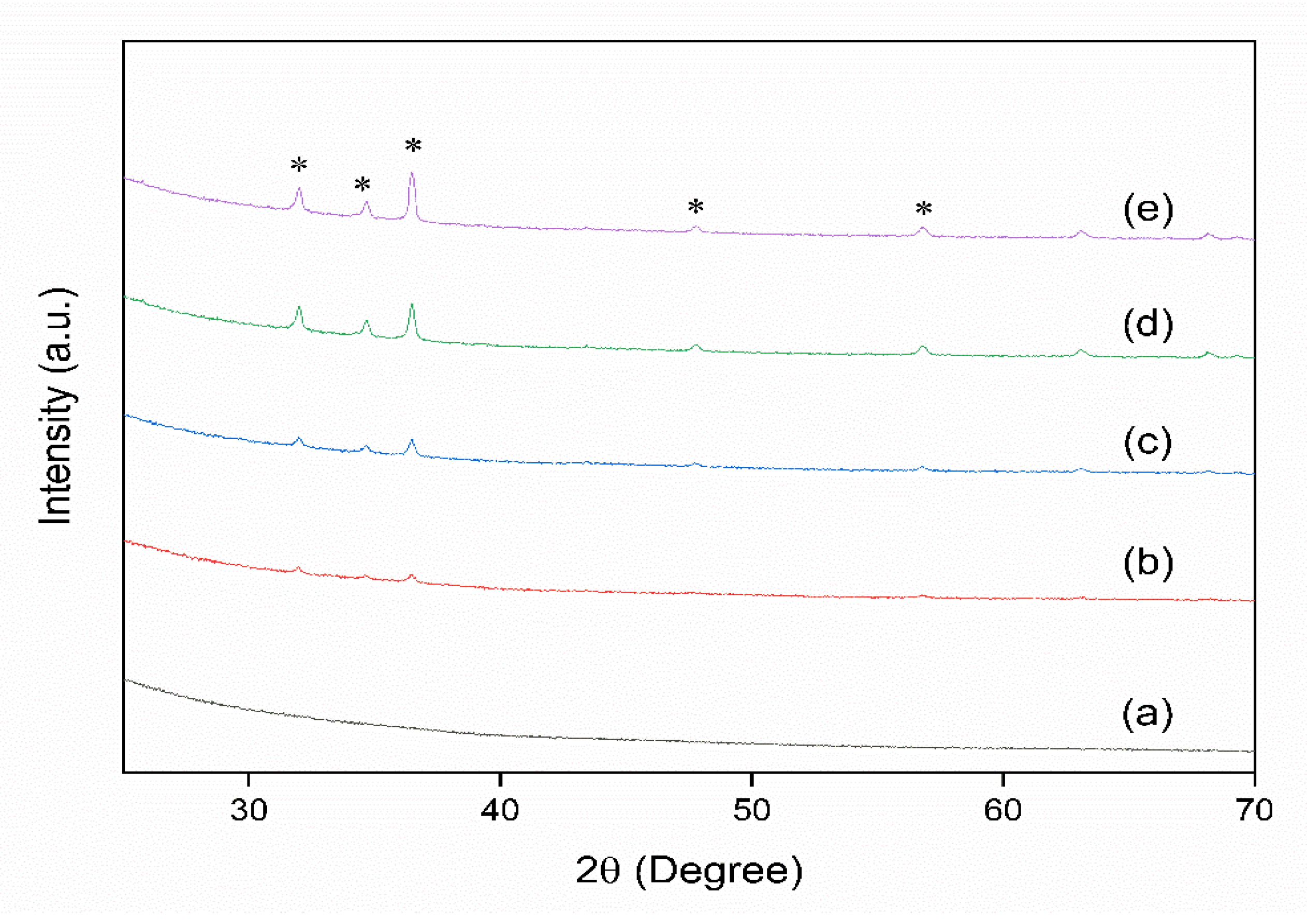
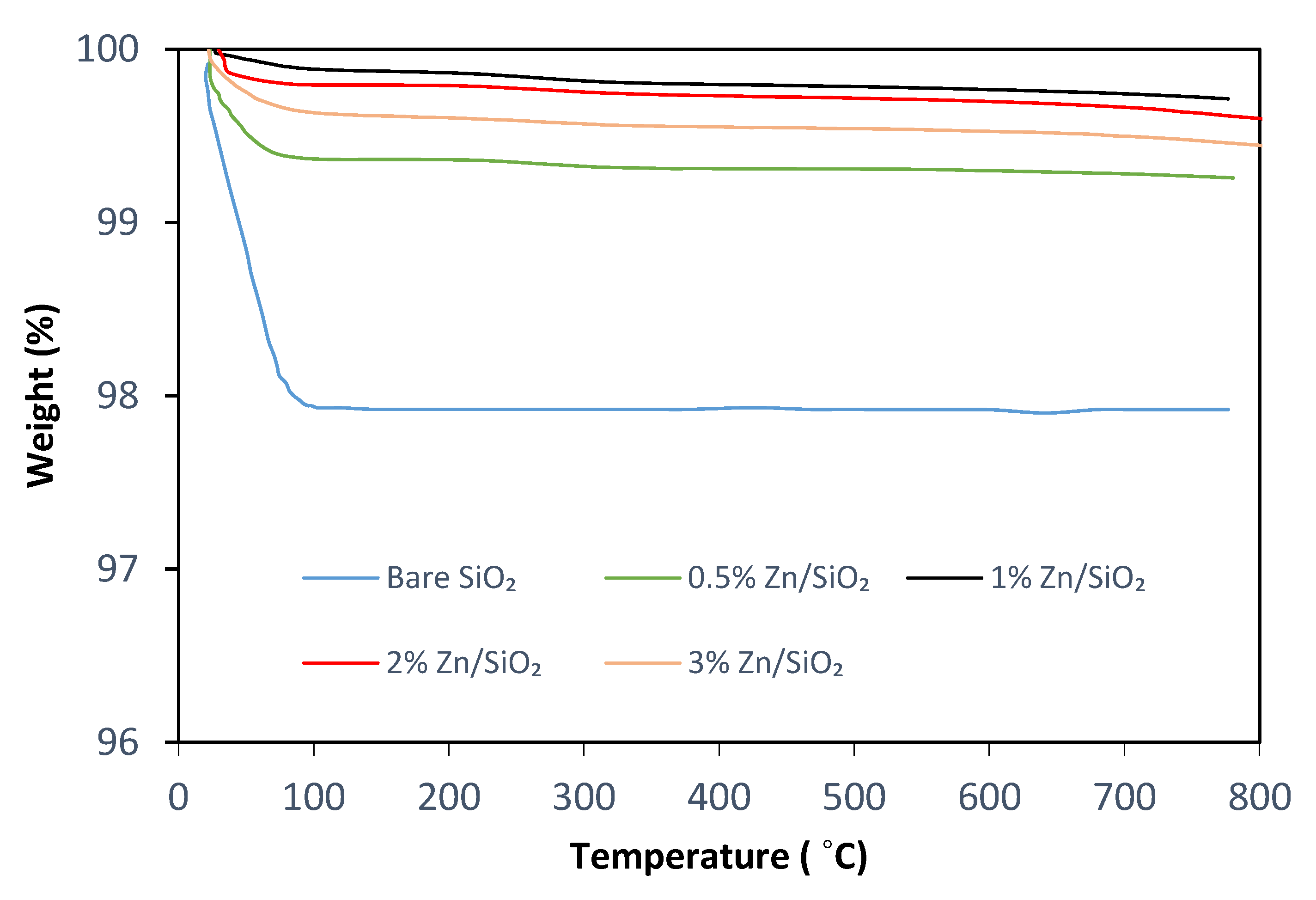
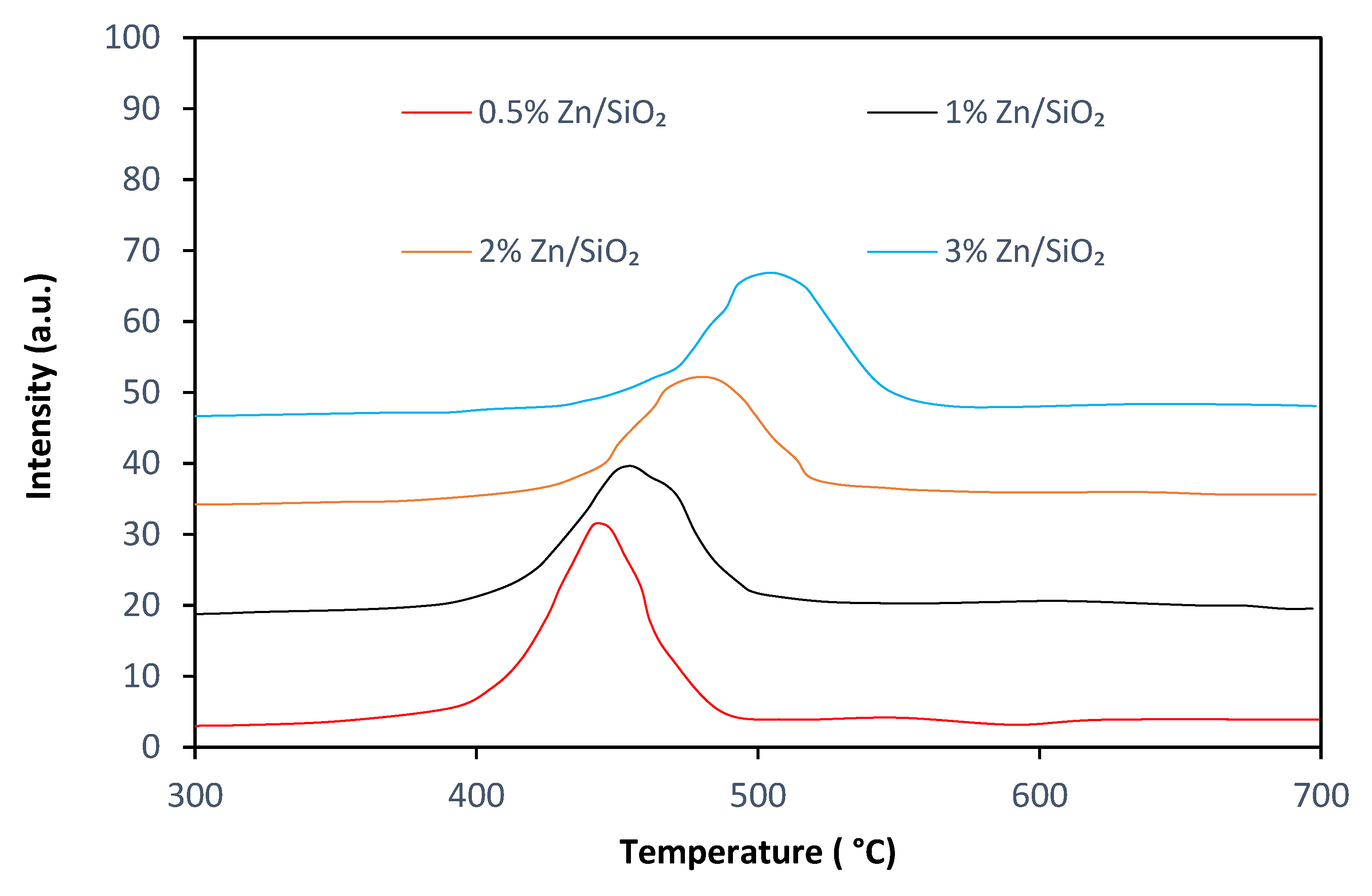
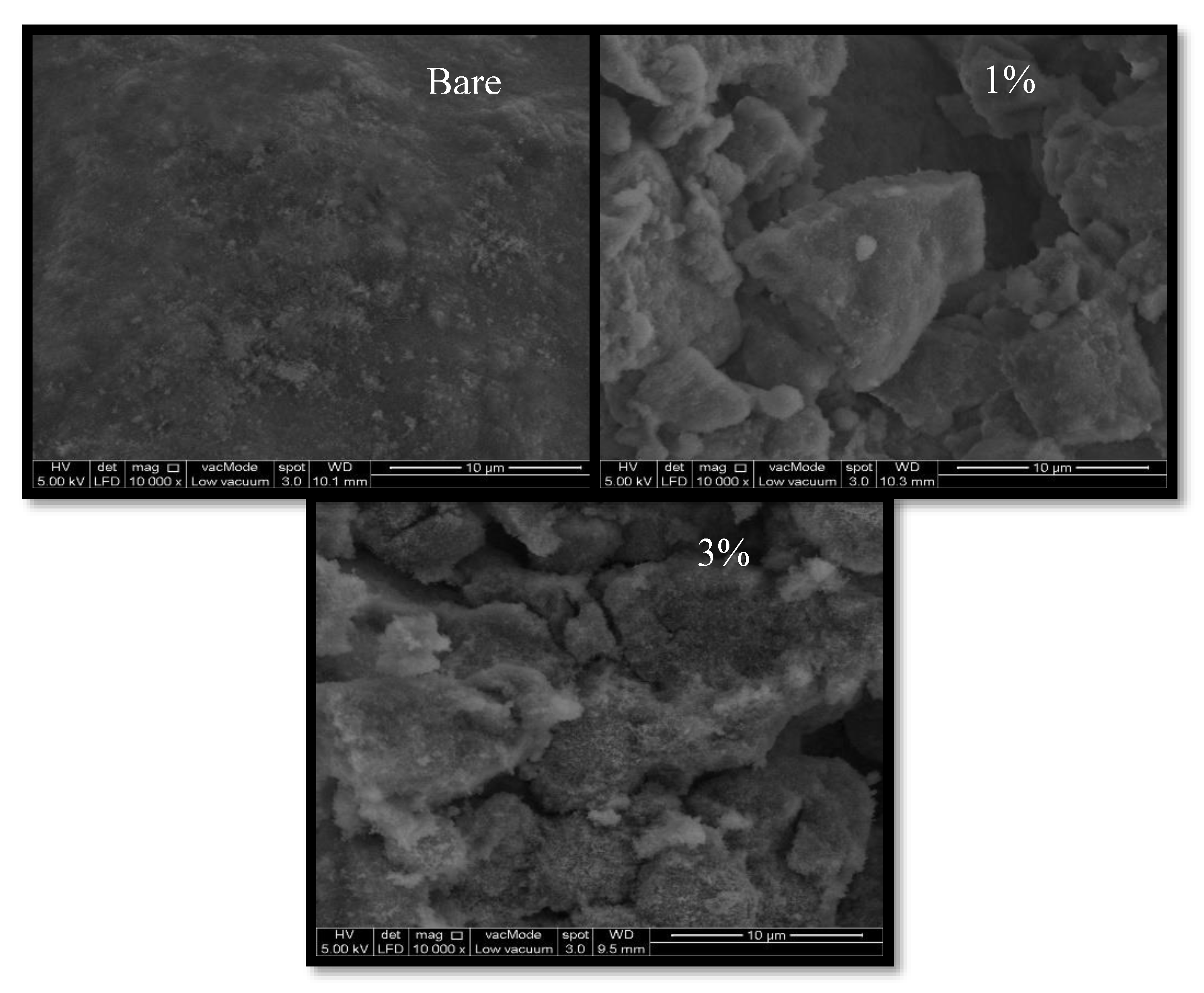
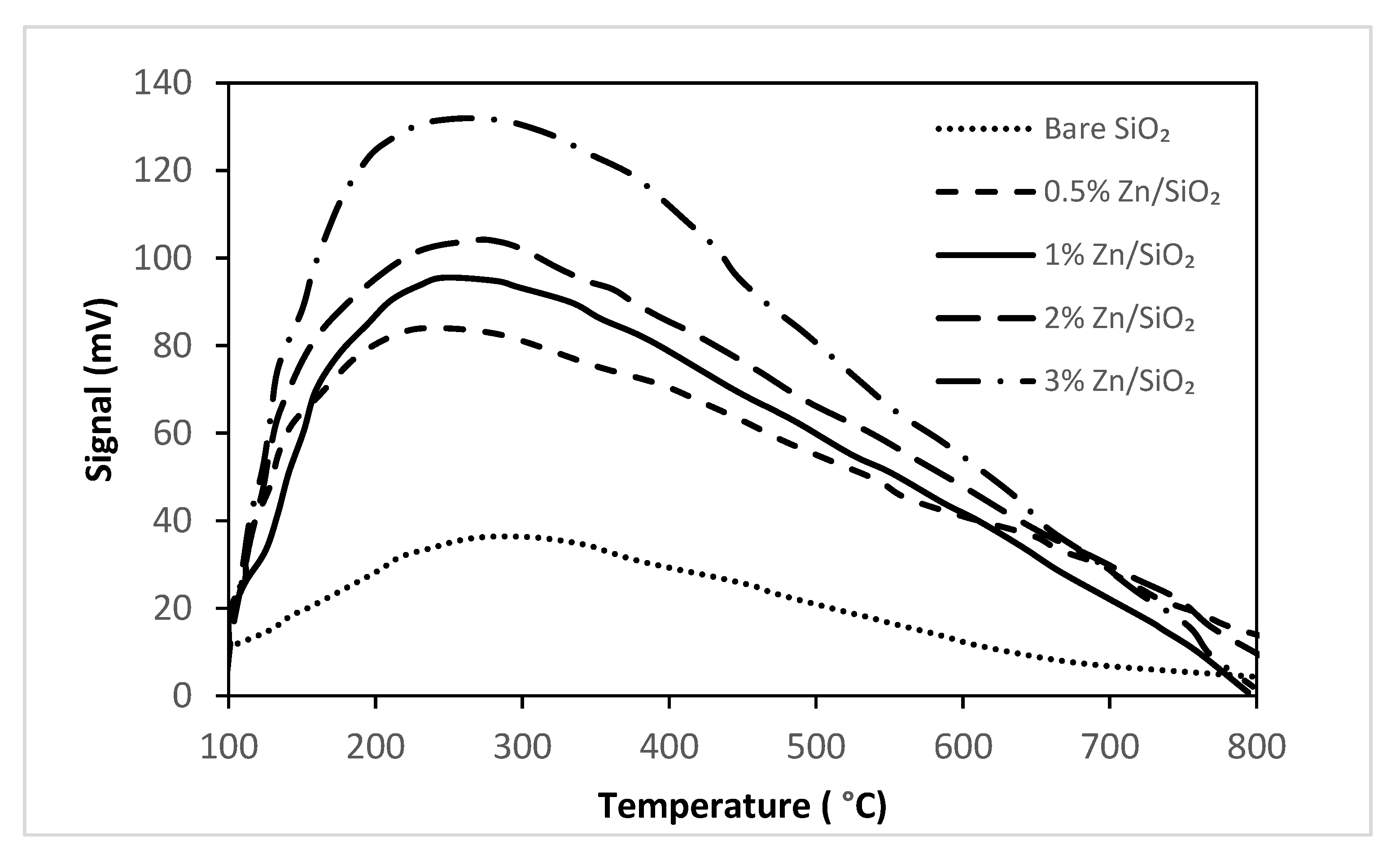
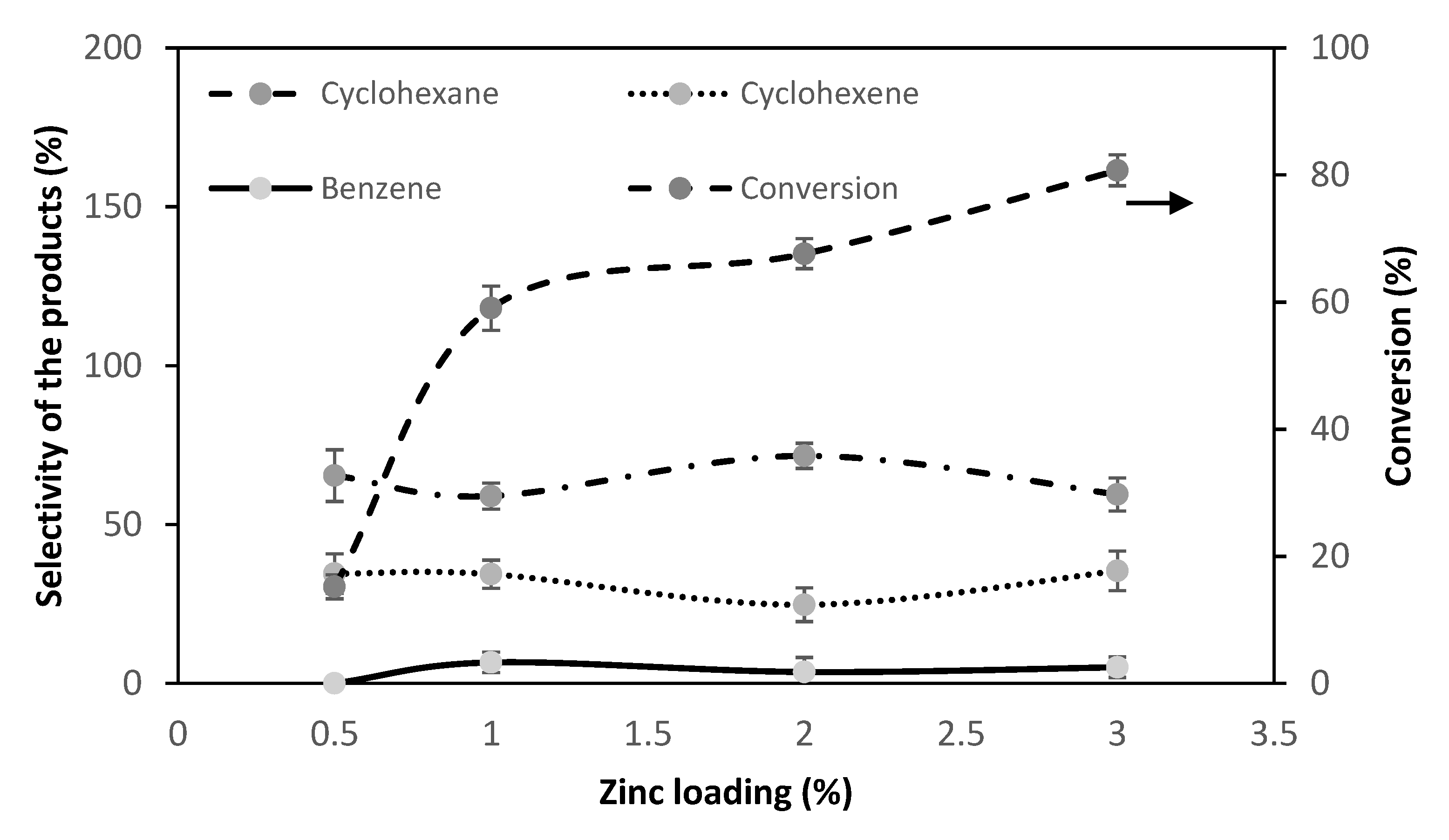
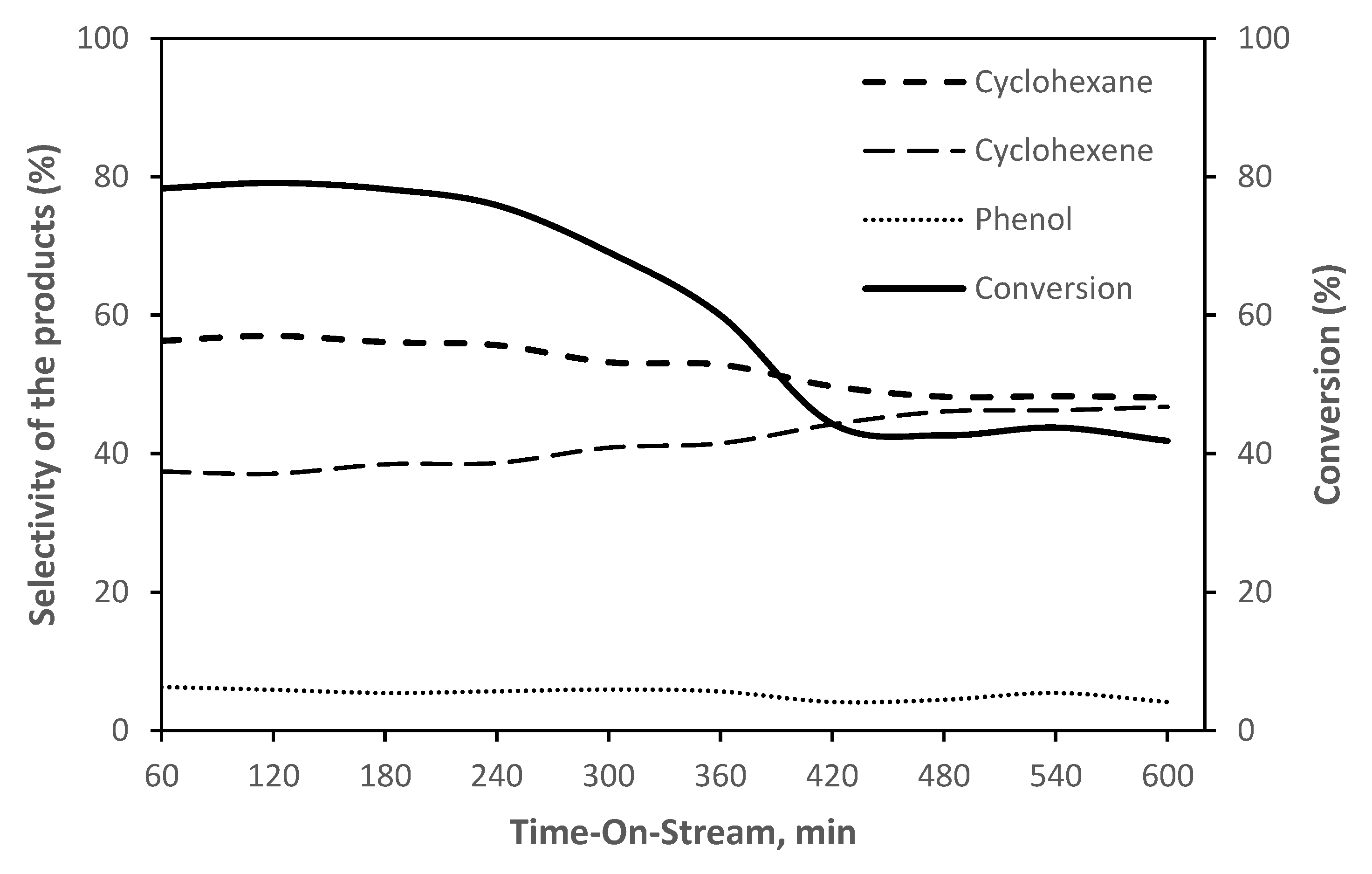
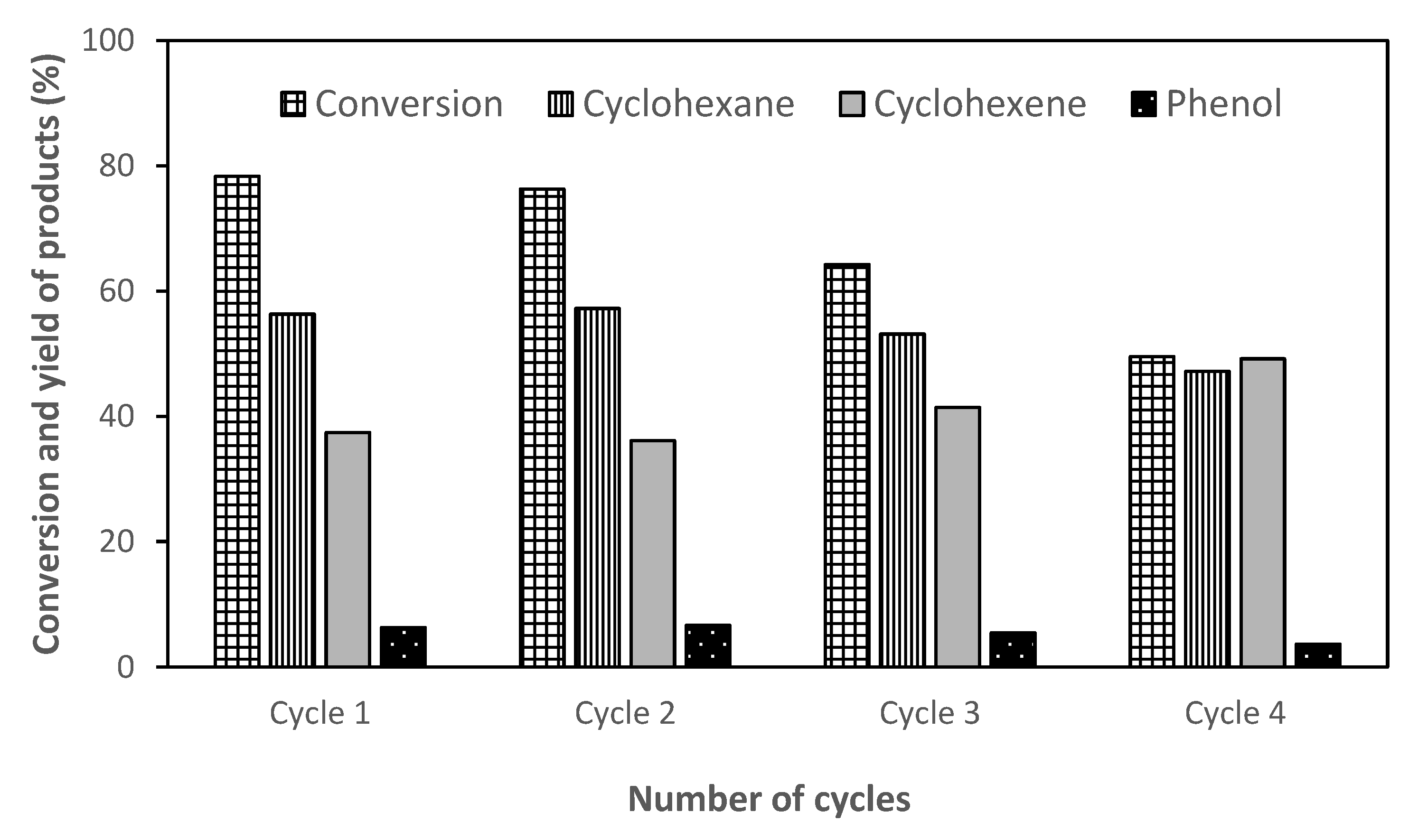
| Catalyst (Nominal Loading) | SBET (m2/g) | dXRD (nm) | Pore Volume (cm3/g) | Pore Size (Å) | Real Doped Zn (wt%) | Acidity of Catalyst (mmol/g) |
|---|---|---|---|---|---|---|
| Bare SiO2 | 185.5 | - | 1.300 | 280.220 | - | 0.108 |
| 0.5% Zn/SiO2 | 185.2 | 48 | 1.300 | 280.220 | 0.46 | 0.357 |
| 1% Zn/SiO2 | 184.7 | 49 | 1.300 | 280.940 | 0.91 | 0.370 |
| 2% Zn/SiO2 | 181 | 51 | 1.274 | 281.906 | 1.8 | 0.422 |
| 3% Zn/SiO2 | 173.3 | 60 | 1.284 | 283.819 | 2.53 | 0.481 |
| Catalyst (Nominal Loading) | Conversion of Phenol (%) | Selectivity (%) | ||
|---|---|---|---|---|
| Benzene | Cyclohexene | Cyclohexane | ||
| 0.5% Zn/SiO2 | 15 | 0 | 34.57 | 65.43 |
| 1% Zn/SiO2 | 59 | 6.62 | 34.40 | 58.98 |
| 2% Zn/SiO2 | 68 | 3.60 | 24.78 | 71.62 |
| 3% Zn/SiO2 | 80 | 6.10 | 25.42 | 68.48 |
© 2020 by the authors. Licensee MDPI, Basel, Switzerland. This article is an open access article distributed under the terms and conditions of the Creative Commons Attribution (CC BY) license (http://creativecommons.org/licenses/by/4.0/).
Share and Cite
Pourzolfaghar, H.; Abnisa, F.; Wan Daud, W.M.A.; Aroua, M.K.; Mahlia, T.M.I. Catalyst Characteristics and Performance of Silica-Supported Zinc for Hydrodeoxygenation of Phenol. Energies 2020, 13, 2802. https://doi.org/10.3390/en13112802
Pourzolfaghar H, Abnisa F, Wan Daud WMA, Aroua MK, Mahlia TMI. Catalyst Characteristics and Performance of Silica-Supported Zinc for Hydrodeoxygenation of Phenol. Energies. 2020; 13(11):2802. https://doi.org/10.3390/en13112802
Chicago/Turabian StylePourzolfaghar, Hamed, Faisal Abnisa, Wan Mohd Ashri Wan Daud, Mohamed Kheireddine Aroua, and Teuku Meurah Indra Mahlia. 2020. "Catalyst Characteristics and Performance of Silica-Supported Zinc for Hydrodeoxygenation of Phenol" Energies 13, no. 11: 2802. https://doi.org/10.3390/en13112802
APA StylePourzolfaghar, H., Abnisa, F., Wan Daud, W. M. A., Aroua, M. K., & Mahlia, T. M. I. (2020). Catalyst Characteristics and Performance of Silica-Supported Zinc for Hydrodeoxygenation of Phenol. Energies, 13(11), 2802. https://doi.org/10.3390/en13112802







